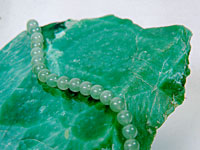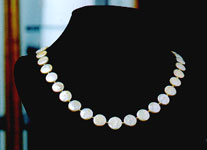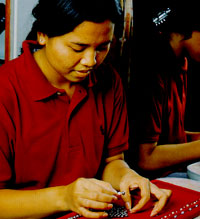The Paragon Group Fashion Jewelry Pearls
Home » Practical Information » Indonesian Community and Culture » Handicrafts »
Pearls of Wisdom - Beautiful Indonesian Jewelry
 Word of mouth is a powerful force in the retail world - and that's probably the manner most people take found Fandiasta, past hearing almost the pearl shop from a satisfied customer.
Word of mouth is a powerful force in the retail world - and that's probably the manner most people take found Fandiasta, past hearing almost the pearl shop from a satisfied customer.
I call back my starting time introduction to Fandiasta in the mid-90s. A friend who lived in Pondok Indah told me nearly this dandy pearl shop where you lot could become necklaces made while you wait; but information technology was far, far away. "Where?" I asked. "In Kemanggisan," she said. Well, since I lived in nearby Kebun Jeruk, Kemanggisan didn't seem then far away to me. Since that first visit, I've referred numerous expats to the shop and oasis't had a disappointed friend even so. What a find!
Fandiasta
Located in the residential neighborhood of Kemanggisan Ilir behind Slipi Jaya Plaza, Fandiasta is a jewelry lover's paradise. Hundreds of ropes of most every type of pearl imaginable and a broad assortment of ropes of semi-precious stone beads, are laid out on the counters, hung from racks or displayed throughout the shop.
 Ibu Fan Sindhunata established Fandiasta in 1976, providing accessories for Javanese traditional wedding ceremony dress. Some of these accessories still remain in the shop, evoking memories of their early years in business organisation. Today, her husband, Pak Sigit Sindhunata, their son Indra and their nephew Robby carry on the tradition of customer service that Ibu Fan was famous for.
Ibu Fan Sindhunata established Fandiasta in 1976, providing accessories for Javanese traditional wedding ceremony dress. Some of these accessories still remain in the shop, evoking memories of their early years in business organisation. Today, her husband, Pak Sigit Sindhunata, their son Indra and their nephew Robby carry on the tradition of customer service that Ibu Fan was famous for.
In the 90s, the focus changed completely to the creation of pearl jewelry, utilizing pearls (mutiara) cultivated in farms in Maluku. The more contempo introduction of semi-precious stones and crystal jewelry has further expanded the range of goods sold at Fandiasta. The semi-precious stone beads come both from Indonesia and beyond its borders, with over 30 types of stones - from Amethyst to White Onyx.
Look through the pearls that adorn the counters at Fandiasta; you're sure to find something to delight yous. The price per standard 16-inch (40 cm.) strand ranges from Rp 45,000 to over Rp 4 million.
While the perfect round spheres sought later on by well-to-practise pearl connoisseurs are tucked away in the special  collection, the so-called art-shaped pearls, too known as baroque (imperfect), or semi-baroque, are displayed throughout the store in affluence. The baroque pearls are increasingly pop and come in a diverseness of non-spherical shapes and colors and are referred to by their shape - rice, corn, pear, and others.
collection, the so-called art-shaped pearls, too known as baroque (imperfect), or semi-baroque, are displayed throughout the store in affluence. The baroque pearls are increasingly pop and come in a diverseness of non-spherical shapes and colors and are referred to by their shape - rice, corn, pear, and others.
To cater to the tastes of mode-witting women, Fandiasta also stocks dyed pearls. These are pearls of a bottom quality which have been colored either through a laser process or through the food substances that are fed to the oyster while it is forming the pearl. Majestic, blue and green baroque and semi-baroque pearls tin be combined with natural colored pearls to create a truly unique necklace or bracelet.
Create your own necklace
 Unique to Fandiasta is the on-the-spot assembly service they offering. Just cull the ropes of pearls or stones yous want, select the accent beads or squeeze design you want to use, then work with the skilled jewelry makers to blueprint the slice yous want to your exact length and design specifications. All that remains is to take a seat and conversation with your friends while the skilled young gals assemble your jewelry.
Unique to Fandiasta is the on-the-spot assembly service they offering. Just cull the ropes of pearls or stones yous want, select the accent beads or squeeze design you want to use, then work with the skilled jewelry makers to blueprint the slice yous want to your exact length and design specifications. All that remains is to take a seat and conversation with your friends while the skilled young gals assemble your jewelry.
Ane of the most popular items is the floating or illusion necklace where small pearls are set at a distance from each other on a super thin filament of nylon. Even from a close altitude the thread seems to disappear, giving the illusion of pearls floating on your peel.
While ropes of pearls and stone beads are the specialty of the store, a minor selection of earrings and set pearls are available equally well.
Well-known hush-hush of avid expat shoppers
The nationality of shoppers at Fandiasta ranges the full latitude of the international community in Jakarta. Gorging  Japanese collectors seek the excellent quality pearls for expert prices and the average day will run across a steady stream of Europeans, N and South Americans and Asians enjoying the excellent quality, good service and friendly atmosphere besides.
Japanese collectors seek the excellent quality pearls for expert prices and the average day will run across a steady stream of Europeans, N and South Americans and Asians enjoying the excellent quality, good service and friendly atmosphere besides.
The shop is a well-known secret of the diplomatic and international concern customs. Guests of land are accompanied to Fandiasta by embassy and ministerial staff. Charts with translations of the names of stones in Japanese and Mandarin are available every bit all items are labeled in English. Even famous Indonesian jewelry designers can be seen having their creations fabricated by the skilled artisans at Fandiasta.
Consult with Indra, the owner's son, or Robby, the possessor's nephew and they'll assist you put together the perfect necklace or bracelet.
Pearl cultivation in Indonesia
For centuries, pearl defined have sought oysters in the articulate waters of the Indonesian archipelago. The oysters were harvested for their valuable inner female parent of pearl beat, which was used to make buttons. On rare occasions pearls  were found inside, a valuable notice. Stories of life in Batavia in the 1600s make mention of Arab traders of pearls and their popular wares.
were found inside, a valuable notice. Stories of life in Batavia in the 1600s make mention of Arab traders of pearls and their popular wares.
Traditional diving and its very low rate of success in finding pearls has been largely replaced in recent decades by the cultivation of cultured pearls. In the tardily 1800s, three Japanese inventors, the well-nigh famous of which was Mikimoto, discovered the technique to civilisation both saltwater and freshwater pearls. Pearl farms, found in Cathay, Japan, the US and the tropical waters of Southeast Asia produce millions of cute cultural pearls annually, which is primarily what is constitute on the market today.
The Japanese have been interested in cultivating pearls in Republic of indonesia. By the mid-1990s, heretofore small-scale interests had led to major investment by domestic and Japanese investors in the cultured pearl industry in Republic of indonesia, not only in the province of Maluku, simply besides in Southeast and Central Sulawesi, West Nusa Tenggara, Lombok and Lampung. In the last few years, some pearl cultivation has moved out of the areas of unrest in Maluku and Sulawesi and pearl cultivators are finding new sites in the clear waters of Papua and off other islands to cultivate their treasures.
 In Republic of indonesia, the main cultivation is of South Sea Pearls, grown in saltwater farms in the argent lip or gilt lip oyster (Pinctada Maxima). This type of oyster grows well in the waters off Indonesia, Australia, the Philippines, and Japan. The natural colored pearls produced past these oysters include silver/white, silver, pink, foam and gold. The proper term for these pearls is "saltwater cultured pearls". The high-luster, perfectly spherical white pearl commands the highest price, as information technology tin can take the oyster many years to grow the largest pearls.
In Republic of indonesia, the main cultivation is of South Sea Pearls, grown in saltwater farms in the argent lip or gilt lip oyster (Pinctada Maxima). This type of oyster grows well in the waters off Indonesia, Australia, the Philippines, and Japan. The natural colored pearls produced past these oysters include silver/white, silver, pink, foam and gold. The proper term for these pearls is "saltwater cultured pearls". The high-luster, perfectly spherical white pearl commands the highest price, as information technology tin can take the oyster many years to grow the largest pearls.
Whatever the shape or size, the work of the oyster to eolith the thousands of layers of thin calcium carbonate crystals, creates beautiful pearls which have been treasured by women for jewelry and ornament for centuries. Neither cut nor polished, pearls are the only natural gem that comes ready to wear.
A Layman'due south Guide to Pearls
Pearls are graded past experts on their:
Luster (surface luminescence, the smoothen on the surface of the pearl that reflects light)
Nacre (thickness of the blanket the clam forms around the centre)
Blemish (imperfections that disturb the surface smoothness of the pearl)
Shape (round, pear shaped or irregularly shaped)
Color (natural colour depends on the species of the pearl. Information technology's a combination of body color (white, lite pink or pinkish, low-cal cream, and night cream, yellow or aureate) and overtone (pink, argent, and green)
Size (the larger the pearl, the rarer and more than expensive)
Mabe pearls are as well very popular with expats in Indonesia. Also known as button or cicatrice pearls, mabe are a half-spherical cultured pearl which is grown on the inside shell of the aforementioned type of oyster that grows the South Sea pearls inside the mollusk'due south trunk. The pearl is cutting away from the inner shell, and then backed with mother-of-pearl. They are especially attractive as they are big in size and lay flat.
Robby, Owner
Fandiasta
Jl. Olah Raga I/1B
Kemanggisan Ilir, Slipi
Jakarta Barat 11480
Tel. 536-4520, 533-0021, 534-6771
Open Mon through Saturday ix:00am to 5:00pm
Witten past Danielle Surkatty
A version of this article was first published in Jakarta Kini, a publication of Indo Multi Media.
Photos by Jan Dekker

0 Response to "The Paragon Group Fashion Jewelry Pearls"
Post a Comment